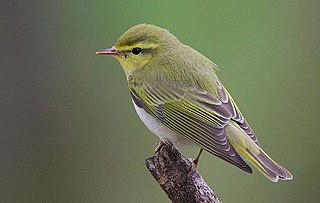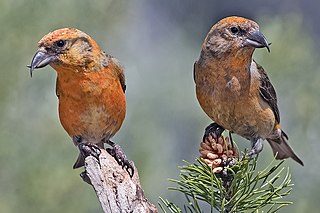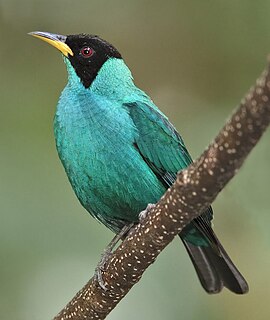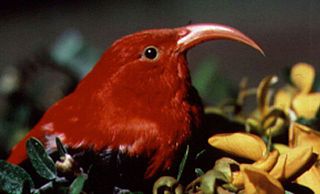This page is based on this
Wikipedia article Text is available under the
CC BY-SA 4.0 license; additional terms may apply.
Images, videos and audio are available under their respective licenses.

Various Passeriformes are commonly referred to as warblers. They are not necessarily closely related to one another, but share some characteristics, such as being fairly small, vocal, and insectivorous.

The tanagers comprise the bird family Thraupidae, in the order Passeriformes. The family has an American distribution. The Thraupidae are the second-largest family of birds and represent about 4% of all avian species and 12% of the Neotropical birds.

The Laysan finch is a species of Hawaiian honeycreeper, that is endemic to the Northwestern Hawaiian Islands. It is one of four remaining finch-billed Hawaiian honeycreepers, and is closely related to the smaller Nihoa finch. The Laysan finch is named for Laysan, the island to which it was endemic on its discovery. It was subsequently introduced to a few other atolls, and its historical range included some of the main islands.

The green honeycreeper is a small bird in the tanager family. It is found in the tropical New World from southern Mexico south to Brazil, and on Trinidad. It is the only member of the genus Chlorophanes. The purplish honeycreeper, a bird from Venezuela known only from the type specimen, is now thought to be an intergeneric hybrid between the green honeycreeper and either the red-legged honeycreeper or the blue dacnis.

The purple honeycreeper is a small bird in the tanager family. It is found in the tropical New World from Colombia and Venezuela south to Brazil, and on Trinidad. A few, possibly introduced birds have been recorded on Tobago. The species is a bird of northern South America, and besides the Amazon Basin and the Guianas, a coastal range occurs west of the Andes, including parts of southern Panama. In the south, its range extends to the extreme western Pantanal. Though it is most frequently seen in the lowlands up to 3,300 ft ASL or so, it has been encountered as high as 7,500 ft ASL.

The red-legged honeycreeper is a small songbird species in the tanager family (Thraupidae). It is found in the tropical New World from southern Mexico south to Peru, Bolivia and central Brazil, Trinidad and Tobago, and on Cuba, where possibly introduced.

The blue dacnis or turquoise honeycreeper is a small passerine bird. This member of the tanager family is found from Nicaragua to Panama, on Trinidad, and in South America south to Bolivia and northern Argentina. It is widespread and often common, especially in parts of its South American range.

The shining honeycreeper is a small bird in the tanager family. It is found in the tropical New World in Central America from southern Mexico to Panama and northwest Colombia. It is sometimes considered to be conspecific with the purple honeycreeper, but the two species breed sympatrically in eastern Panama and northwest Colombia.

The cardueline finches are a subfamily, Carduelinae, one of three subfamilies of the finch family Fringillidae, the others being the Fringillinae and the Euphoniinae. The Hawaiian honeycreepers are now included in this subfamily. Cardueline finches are specialised seed eaters, and unlike most passerine birds, they feed their young mostly on seeds, which are regurgitated. Besides this, they differ from the other finches in some minor details of their skull. They are adept at opening seeds and clinging to stems, unlike other granivorous birds, such as sparrows and buntings, which feed mostly on fallen seeds. Some members of this subfamily are further specialised to feed on a particular type of seed, such as cones, in the case of crossbills. Carduelines forage in flocks throughout the year, rather than keeping territories, and males defend their females rather than a territory or nest.

Drepanis is a genus of Hawaiian honeycreeper in the Carduelinae subfamily of the Fringillidae family.

Akialoa is an extinct genus of Hawaiian honeycreeper in the Carduelinae subfamily of the Fringillidae family.

Chloridops is an extinct genus of Hawaiian honeycreeper in the Carduelinae subfamily of the Fringillidae family.

Himatione is a genus of Hawaiian honeycreepers in the Carduelinae subfamily, Fringillidae family.

Paroreomyza is a genus of Hawaiian honeycreeper in the Carduelinae subfamily of the Fringillidae family.

The Laysan honeycreeper or Laysan ʻapapane was an extinct bird species that was endemic to the island of Laysan in the Northwestern Hawaiian Islands.

The purplish honeycreeper is a bird in the Thraupidae, or tanager family. It is known only from the type specimen, a trade-skin held in the British Museum, and is thought to be an intergeneric hybrid between the green honeycreeper and either the red-legged honeycreeper or the blue dacnis, though Hellmayr, in his Catalogue of birds of the Americas and the adjacent islands, considered it a good species.



















